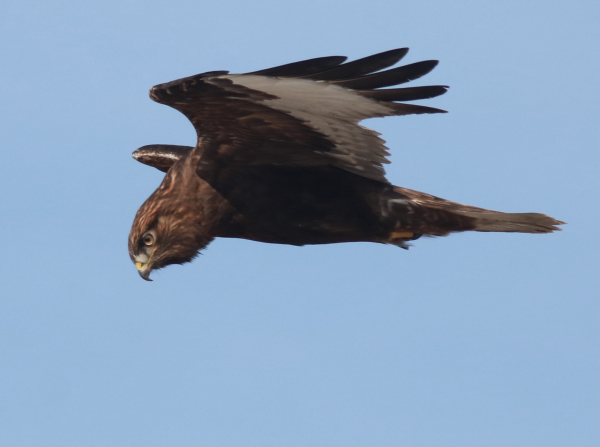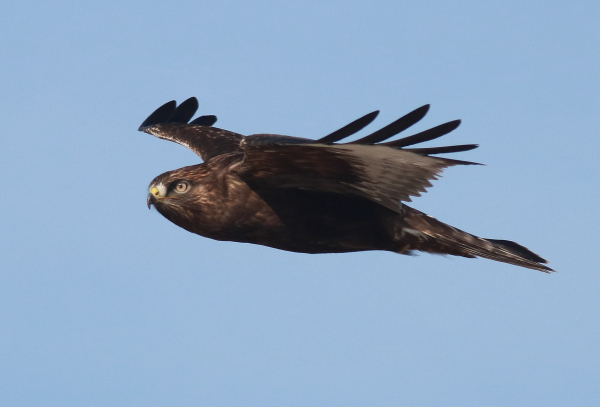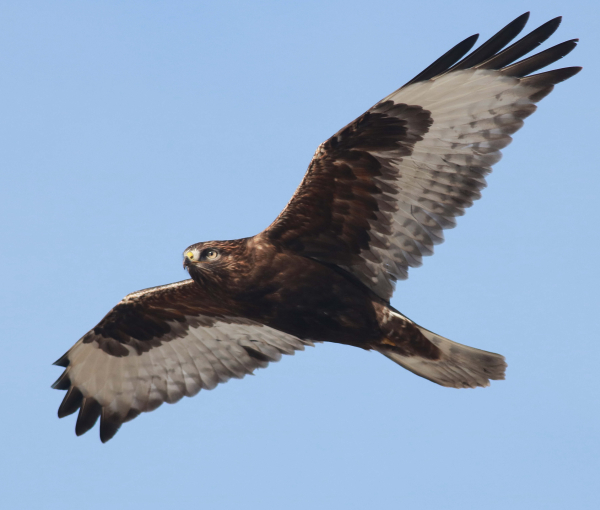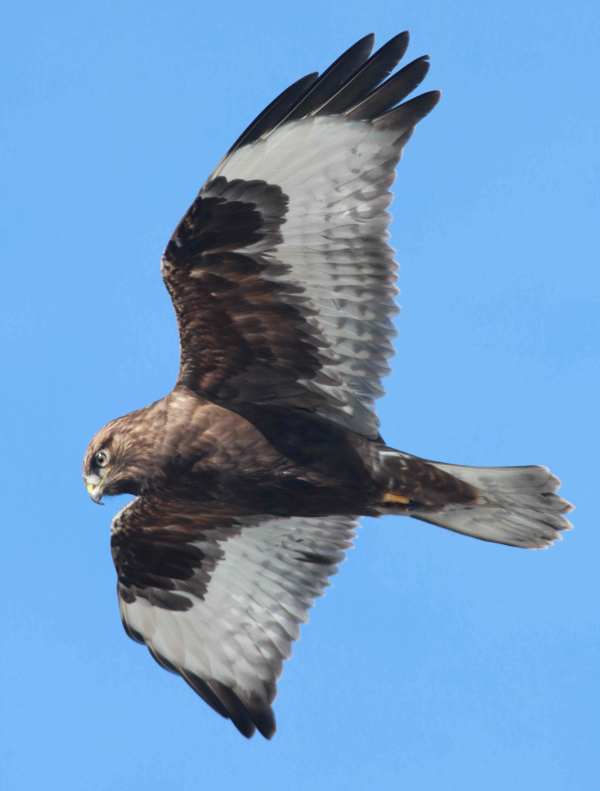In this weekly feature, the “luck factor” is often part of the mix of elements that may be part of a photo session. Birds are very mobile, usually wary, and often unpredictable in their behavior and movements. Even so, last week in this publication’s Editor Afield article, I described another lucky photo opportunity as I headed for home. While still 4 miles north I was surprised to find a dark morph Rough-legged Hawk hovering on the updraft above a lakeshore hill – right next to the road. At first I wasn’t sure it was a dark morph, but after taking a U-turn to get on the good light side of the hunting hawk, I confirmed it was a chocolate-brown dark morph female floating in an almost motionless position as I approached.

The chocolate-colored Rough-legged Hawk, a dark morph female, provided a memorable series of photos, followed by two more opportunities as it returned to the hunting location. The above photo was taken as the raptor flared one wing high to brake its glide and face into the west wind to begin its hunt.
After taking a documentary photo out my window, I was thrilled the hawk actually glided in my direction, only to hover near and above my vehicle. I recorded the raptor flaring with one wing high as it found its spot to hover for a wingbeat, then began to float almost motionless on an updraft. As it intently scanned the ground below, the chocolate-colored hawk extended its neck downward in a rather unique fashion while I continued photographing, excited about the moments of close contact while the bird was positioned in perfect sunlight.
When the chocolate Rough-leg swept off in the direction it came from, I knew I already had some fine photos in camera, but I waited and watched as the hunter worked its way at least a quarter mile away, pausing here and there to “float” along the updrafts created adjacent to the lake. The hawk was barely discernable in the distance when I lowered my binoculars, but I could see when it eventually began retracing its path back in my direction. Using the updraft zone where the lakeshore met the adjacent upland, it methodically worked its way back again, to float even closer to my camera.

Floating on an updraft in a perfect aerodynamic position, the hawk extended its neck downward in a rather unique way, seemingly above prey considering its intent attention focused below.
The trusting hawk provided the opportunity to record its plumage details through my 400mm telephoto lens, and it acted so naturally that it put me at ease so I could photograph in a normal and even relaxed mode rather than my usual tensed up photo mode when I’m in such close company with a rare bird. What a dynamic raptor, literally floating on an updraft of the stout west wind – seemingly just beyond my reach, but well within the reach of my camera lens – whoo-wooo!
The chocolate raptor would break away again, only to repeat its delineation of the lakeshore north and back once more, and revisit my location a third time, floating lower and even closer – almost directly overhead. This time it would turn left rather than right and cross the road to begin hunting along a partly frozen marsh. I continued to watch it a few more minutes, and marveled at the experience this trusting hawk just provided – what luck! Bidding the hawk good luck as it continued hunting, I hustled on home to view the resulting new photos on my computer screen!

The eyes of this bird provide an interesting series of “looks” through the series of photo, and the details of the plumage are especially detailed.
Tech Notes
Again, I was able to stick with my initial camera settings – the usual for a sunny day: Using an ISO of 400 and an aperture of f8, which provided a wide area in focus and a fast shutter speed of 1/1600 of a second – very fast, considering the hawk was barely moving most of the time. I’m thrilled with the resulting photographs, especially those that illustrate this article. I certainly had plenty of time to make any changes to my aperture, shutter speed, or ISO, but that’s an option for another day; today my regular settings proved to be perfect.
Of course, I used the Av mode setting on my camera, which provides an aperture-priority. Using the Av setting, you set your f-stop and the camera automatically provides the corresponding shutter speed under the existing light conditions. I steadied my lens against the top of the window frame and held my breath when I pressed the camera’s shutter button. When the hawk glided to another position, I held the shutter button down for a few seconds to take a series of photos at a fast rate between 3 and 5 frames per second so as not to miss any of the action. To do that, I keep my camera’s drive mode set on ‘continuous shooting,’ and if you don’t want to take more than one photo at a time, that’s easy; just snap a photo as usual without holding the button down for extended seconds.

What a thrill to follow the action of this rare bird in flight at close quarters, and to review the photo series in retrospect, appreciating the bird and the photo opportunities it presented. It’s more than being in the right place at the right time, it’s also positioning yourself in the right place so the lighting is as good as possible, with the cooperation of a trusting bird that allowed that to happen, and came back for more.
Zoom Option
During the final visit by the hawk, she flew a little too close for me to fit her total wingspan into the photo frame. The grand bird was almost directly overhead, in mid-float, and although I had plenty of nice photos, that position was rather unique, making me wish to have my zoom lens in play. My go-to 400mm telephoto lens worked great for every other photo option, but now my zoom lens would have been an improvement. My versatile 35-to-350 zoom lens was within reach, but I didn’t want to risk the possibility that as I changed lenses and zoomed the hawk into the frame the big raptor would leave and I’d be left without a photo at all.

The unusual angle of this photo is due to the fact that the hawk soared very close almost directly overhead. Turning the camera to utilize vertical framing, this image offers an interesting view of the floating raptor.
|
So after taking a couple photos that cut out the top and bottom of the wings – emphasizing the face, body, and tail – I tilted my camera to utilize the added length of a vertical photo frame rather than the usual horizontal – and that worked pretty well. Too often we overlook the vertical option that simply twisting the camera 90 degrees up or down can provide. For me, the resulting photos aren’t as pleasing as the others, primarily because the angle of the hawk is nearly straight overhead, but the photos do offer a little different “angle” on the subject (see the last photo in the series illustrating this article).
It’s hard to explain the excitement levels we birders feel when a trusting bird provides a breath-taking photo opportunity that yields a favorite photo, much less a fine series of photos. And in this case it was not just any bird, or any hawk – it was a chocolate hawk! Well, a chocolate-colored dark morph female Rough-legged Hawk anyway; a very special bird indeed! It’s the payoff for the hours and days in the field – all enjoyable in their own right – and it’s incentive to get out there again the next day, and tomorrow. Good luck, and enjoy the next bird you photograph, whatever flavor it may be!
Article and photographs by Paul Konrad
Share your bird photos and birding experiences at editorstbw2@gmail.com